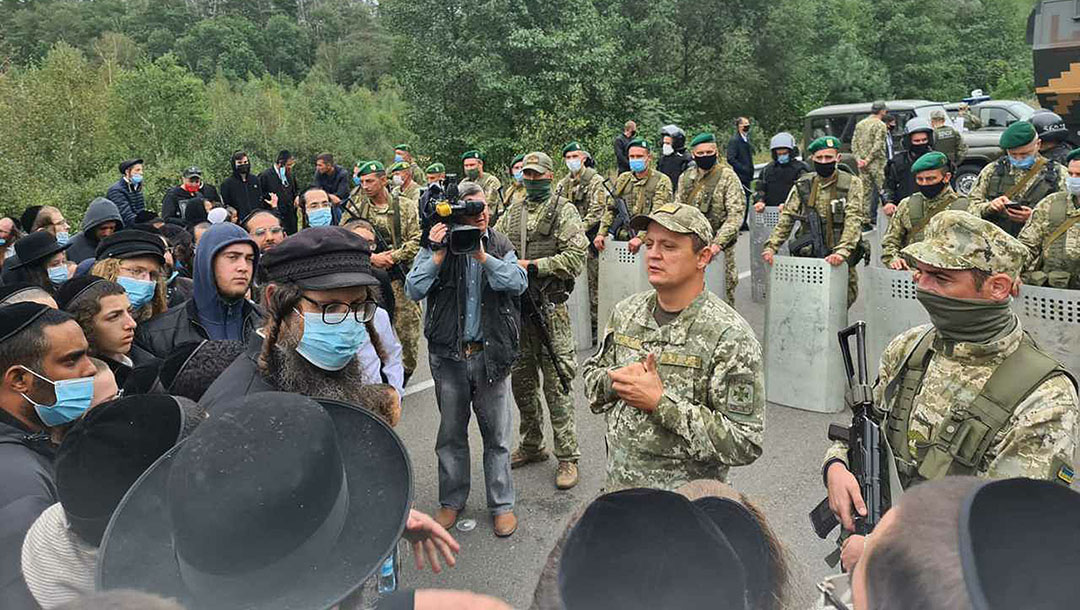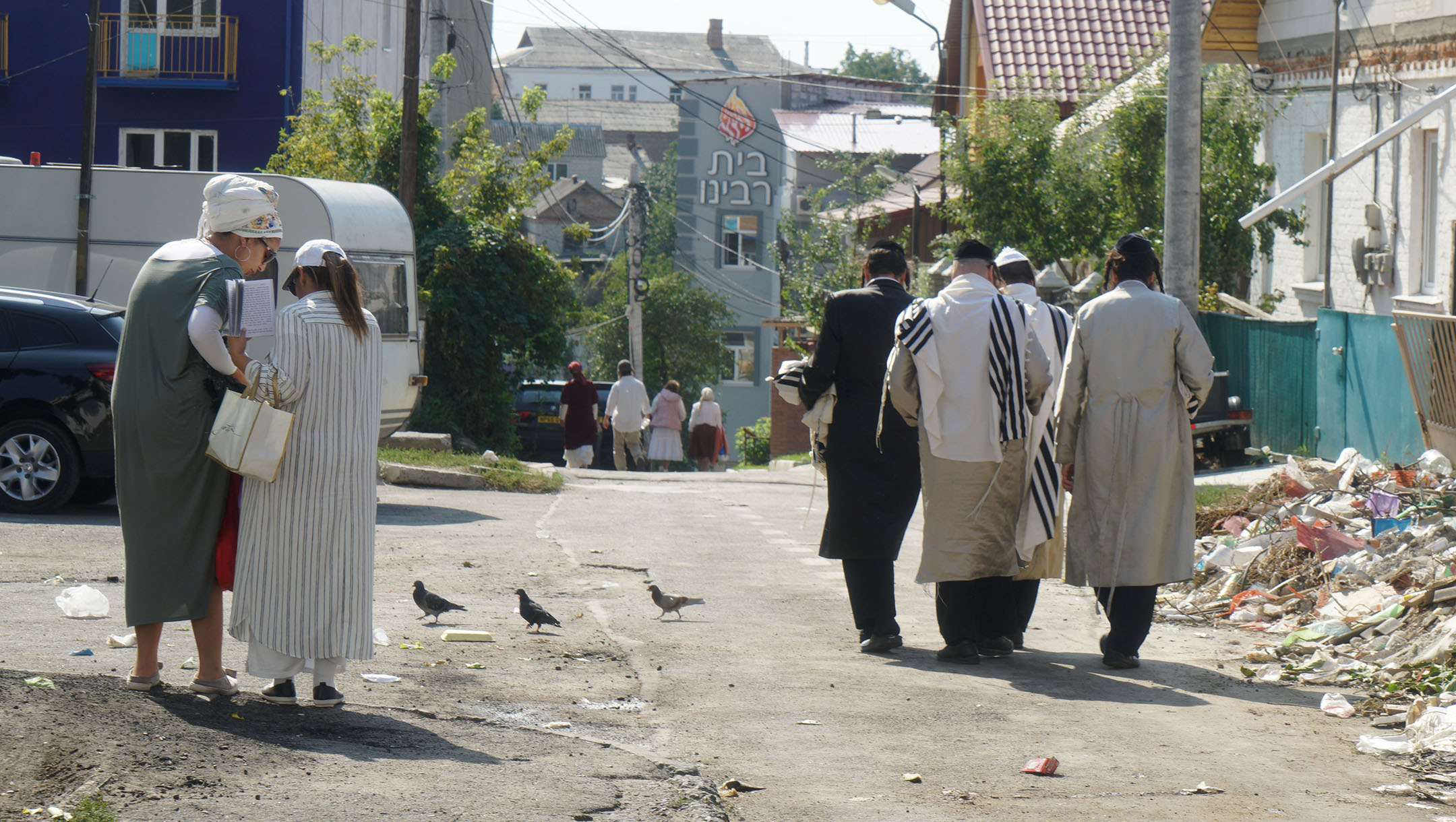The Red Cross is aiding hundreds of Jewish pilgrims who have amassed at Ukraine’s closed borders
Published September 16, 2020
(JTA) — On the border of Belarus and Ukraine, Avremi Vitman tried to shake off the morning chill as he prayed earlier this week.
Vitman was hungry and uncomfortable after yet another night sleeping in his coat, two weeks after arriving in Belarus en route, he hoped, to Uman, the Ukrainian city that is the site of an annual Rosh Hashanah pilgrimage for followers of Rabbi Nachman, founder of the Breslov Hasidic movement.
“Nights are cold here, we sleep in our coats,” Vitman told the Jewish Telegraphic Agency. He arrived at the border crossing on Monday after spending two weeks in Pinsk, sleeping at a compound set up there with help from the local Jewish community. “There’s little food, we share what we have and there are more people coming. Mostly we pray and we pray to be let in.”
ADVERTISEMENT
In a typical year, about 30,000 Breslov followers make the Uman pilgrimage — many believe that reciting a particular selection from the Book of Psalms at his graveside has particular power. This year, with the coronavirus pandemic raging, Ukraine closed its borders starting Aug. 29 in a move widely seen as trying to block them. But hundreds of pilgrims have made the trip anyway.
So many Jewish pilgrims have amassed in the Belarusian city of Gomel that the Red Cross is providing humanitarian aid, setting up a field clinic to serve about 1,000 people who are still hoping to be admitted to Ukraine. Meanwhile, Belarusian soldiers are guarding the border checkpoint there.
Few of the pilgrims came with adequate supplies for a long camping trip. Some brought their children. Now the road leading to the border checkpoint at the grassy fields beside it are dotted with suitcases, children scampering among them.
ADVERTISEMENT
With the temperature dropping to about 50 degrees Fahrenheit at night, some pilgrims have started bonfires for warmth. Families huddle together behind suitcases that they stack to block the chilly winds that blow in that corner of Belarus.
“It’s unreal what’s going on here,” Nachum Klein, a pilgrim, told the Israeli broadcaster Kan on Tuesday.
“What’s happening to the children is particularly shocking,” said Klein, who came to the border with his 9-year-old son. “At around 3 a.m. the wind started picking up, cold winds and children started shivering, and elderly people started turning blue.”
The situation required the Red Cross to set up its tent with heating for children and older adults, Klein said.
“The Red Cross people were handing out tea and blankets to people who were shivering in the wind,” he said.

Jewish pilgrims in Belarus, at the closed Ukraine border, are trying to make their way to Uman, Sept, 15, 2020. (Courtesy of Shahar Eliyahu)
The pilgrims are allowed to return to Minsk, the capital of Belarus, and fly back to their homes, mostly in Israel.
“But coming to Uman is like oxygen, fuel for the entire year,” Klein said. “We’re prepared to sacrifice anything for it.”
According to Vitman, who said he is willing to risk his life to reach Uman this year, as many as 4,000 people had planned to leave Minsk, Pinsk and Gomel on Tuesday for the border checkpoint.
“There are more and more people coming here,” he said.
Vitman said he assumed some “arrangement” would allow him entry to Ukraine once he arrived. Others, he said, had dressed up as secular tourists to get into the country, and he heard a few made it through, showing “there was discrimination against Orthodox Jews.”
Are the pilgrims in Belarus arriving at the border to pressure the Ukrainian authorities to allow them to enter?
“It’s not about pressure, it’s about trying to get as close to Rebbe Nachman as possible, and right now this is closest,” Vitman said.
He grew up in Ashdod, in southern Israel, and recalled that he came to Uman for the first time when he was a month old. His parents are also among the hardcore believers of the Bratslav philosophy, with its emphasis on joy as a vehicle for worship.
“I was here each year at least once since,” Vitman said. “It’s a promise. I made the promise, and Rabbi Nachman’s promise was made to me.”
Klein said the pilgrims are willing to do what it takes to prevent spreading the coronavirus, which is now at a high in Israel.
“We’re prepared to undergo three tests, if that’s what’s required, and spend as much time as necessary in confinement back home in Israel, if that’s necessary,” he said. “We’ll also keep to social distancing rules in Uman. We’re not different to any other tourist leaving Israel right now, but are being treated very differently. It’s discriminatory.”

Jews walk down an alley leading to Pushkina Street in Uman, Sept. 8, 2017. (Cnaan Liphshiz)
Some videos showed the pilgrims near the Gomel checkpoint dancing while hugging in violation of social distancing measures, Kan’s Mendi Guzman reported.
“There are always mishaps, but on a whole there will be total observance,” Klein assured him.
Uman, in central Ukraine about 130 miles from Kyiv, the capital, now has about 1,500 foreigners who came before the border shutdown to beat it. The city of 82,000 has a Jewish community of about 300, most of them Israelis, who settled there in recent years.
Klein in the Kan interview said the Israeli government “left them in the cold” by not helping convince the Ukrainian government to let them in. Many Breslovers seem to be especially angry at Shas, the Israeli Orthodox Sephardic party, which has many supporters in Breslov circles.
“It’s outrageous, instead of helping the Jews stranded in dire straits, Shas is lashing out at them,” one prominent Breslov activist, Zadok David, wrote on Facebook.
David was reacting to the comments of an Israeli lawmaker, Yakov Margi, about who is responsible for the current plight of the pilgrims and their children.
“The person who decided to travel even though they knew the border is closed, they can assume the responsibility for the situation in which they put themselves, their children and others,” Margi said.















